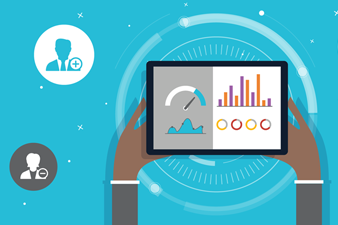
The concept of the digital power plant has been receiving a lot of attention and calls for an assessment of what it really means and what the maturing technologies have to offer power generation companies. At the December 2017 POWERGEN Conference, Mitsubishi Hitachi Power Systems President and CEO Paul F. Browning announced they had broken ground on a combined-cycle power plant capable of fully autonomous operation slated for completion in 2020. Emerging digital analytics platforms are transforming how power generation companies collect, use, and learn from their data to realize new opportunities for reducing costs, improving efficiency, and managing risk. In a market environment with exceptionally lean margins, the oldest legacy generating units can benefit from this digital transformation just as much as the newest cutting-edge construction.

Key Details
Recorded and real-time data, by itself, has limited value to plant operation. Every data point must be stored, processed, and analyzed fast and accurately to provide actionable intelligence to the organization and add substantial value to a strong asset management program. The most effective digital analytics platforms comprise numerous and multilayered data sources:
- A control system
for a typical >2 GW retrofitted coal plant can be connected to as many as:- 10,000 online sensors
- 50,000 alarm points
- 18,000 live graphic displays
- 12,000 control drawings
- All inputs from controls and off-line testing
- Intelligent platforms can be programmed with institutional expert knowledge, including:
- Learnings from long-term experience with design, manufacturing, testing, and commissioning all components and systems
- Information on legacy technologies from variety of manufacturers
- Global databases and expertise on condition assessment
- Globally employed operational risk assessment tools
- Knowledge gained from numerous forensic investigations to determine unexpected failure causes
- Historical data collected from systems must be continuously updated and synchronized across the generation fleet:
- Automatic synchronization means every user at any unit, plant, or remote operating center across a fleet will always be looking at the same data set
- Essential for activities requiring time-series data replay to diagnose an abnormal condition or trace root causes of a system failure
A key data analytics application is benchmarking normal operating conditions and impacts of deviation from acceptable minimum and maximum values. These provide a foundation for advanced pattern recognition and statistical modelling, enabling predictive capabilities.
Implications
- Human capital – digital transformation requires new training and retraining processes, but the dividends are immediate and ongoing:
- Digital platform meets workers where they are with intuitive interfaces, data visualization, and mobile access; greatly accelerating efficiency, accuracy, and utilization of data collection and response
- Digital platforms can capture the expert institutional knowledge otherwise lost when the older generation of plant experts retire
- Newer operators have earlier access to data-driven, decision-making tools informed by decades of expertise
- A fully implemented system has the potential to reduce a facility’s labor requirements as maintenance activities become more targeted and engineering more centralized
- Plant optimization – the operation of every process and component can be indexed to performance benchmarks, communicating the health of systems to operators through an intuitive user interface and automated alerts of abnormal occurrences
- Predictive maintenance – early detection of indicators of equipment problems that enhances established preventive maintenance practices of scheduled servicing
- Process improvement – operators can proactively improve performance by identifying process enhancements, through simulation models, that allow digital experimentation with off-design conditions, operations, and variables such as fuel, temperature, and pressure
- Enhanced IT infrastructure – operators need to consider the full investment and buy-in required to realize the benefits listed above, including significantly increased capacities for data storage, connectivity, and training
- Cybersecurity
- In light of the U.S. Department of Homeland Security’s March 15 report on foreign attacks on industrial control systems and supervisory control and data acquisition systems within energy generation facilities, ensuring the integrity and security of digital systems of connected power plants is more urgent than ever
- A digital platform needs to be designed to work within the operator’s methodology of compliance with NERC’s CIP standards
- Secure connections can be made using a dedicated line (not connected through the internet) between a plant and a remote monitoring center or an encrypted connection using VPN
- The same optimization and predictive maintenance capabilities can and should be applied to the integrity of the digital platform systems and networks
The benefits of this digital transformation are substantial: over a 2.5-year period the 5 GW Yeongheung coal power plant in South Korea identified and successfully addressed 144 abnormal events, such as differential pressure between twin gas air heaters or a sudden drop in flow rate of the hydrogen cooling system for a generator stator. The resulting optimization, improved performance, and avoided failures lead to a savings of $6 million in operations and maintenance costs. Many variations of these capabilities are possible, and most vendors will take an inclusive approach to working with operators to ensure the development of a platform and applications customized to specific needs that deliver meaningful and actionable insights. The near-term promises further development of automated plant technologies and the future possibility of a cognitive power plant.
More Information
Turbomachinery: The journey toward a digital power plant
Power Engineering: Using Predictive Analytics to Minimize Risk Associated with Aging Assets
Schneider: Predictive Analytics at Power Utilities
POWER Magazine: Optimize Power Plant Operations with Industrial Data Management and Predictive Analytics
Mitsubishi Hitachi Power Systems: MHPS-TOMONI Unlocks the Advantages of Digital Power Plants by Leveraging Customer Collaboration
This report is part of ScottMadden’s Fossil Minute series. To view all featured Fossil Minutes, please click here.
Additional Contributing Author: Jonathan Aronoff



